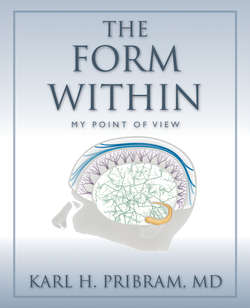Читать книгу The Form Within - Karl H Pribram - Страница 66
На сайте Литреса книга снята с продажи.
Holographic Brainwaves?
ОглавлениеAt a recent conference I was accosted in a hallway by an attendee who stated that he had great trouble figuring out what the brain waves were that constituted the dendritic processing web. I was taken aback. I had not thought about the problem for decades. I replied without hesitation, “Brain waves! There aren’t any. All we have is oscillations between excitatory and inhibitory post- (and pre-) synaptic potential changes.” I went on to explain about Gabor “wavelets” as descriptive of dendritic fields and so forth.
It’s just like water. When the energy of a volley of nerve impulses reaches the “shore” of the retina the pre-synaptic activation forms a “wave-front.” But when activity at the brain cortex is mapped we obtain wavelets, Gabor’s “quanta of information.” The relationship between the interference patterns of spectra and the frequencies of patterns of waves is straightforward, although I have had problems in explaining the relationship to students in the computational sciences. Waves occur in space-time. Spectra do not. Spectra result from the interference among waves—and, by Fourier’s insightful technique, the locus of interference can be specified as a number that indicates the “height” of the wave at that point. The number is represented by a Gabor function (or other wavelet.) Frequency in space-time has been converted to spectral density in the transform domain.
Wavelets are not instantaneous numbers. As their name implies wavelets have an onset slope and an offset slope. Think of a musical tone: you know a little something about where it comes from and a little as to where it is leading.
Note that we are dealing with dendritic patches limited to one or a small congregation of receptive fields—like the bobbing of a raft in the water beyond the shore. There was a considerable effort made to show that there is no overall Fourier transform that describes the brain’s relationship to a percept—but those of us who initially proposed the holographic brain theory always described the transformation as limited to a single or a small patch of receptive fields. By definition, therefore, the Fourier transformation is constrained, windowed, making the transformed brain event a wavelet.
We now need to apply these formulations to specific topics that have plagued the study of perception— needlessly, I believe. The concept that the optics of the eye create a two-dimensional “retinal image” is such a topic.
